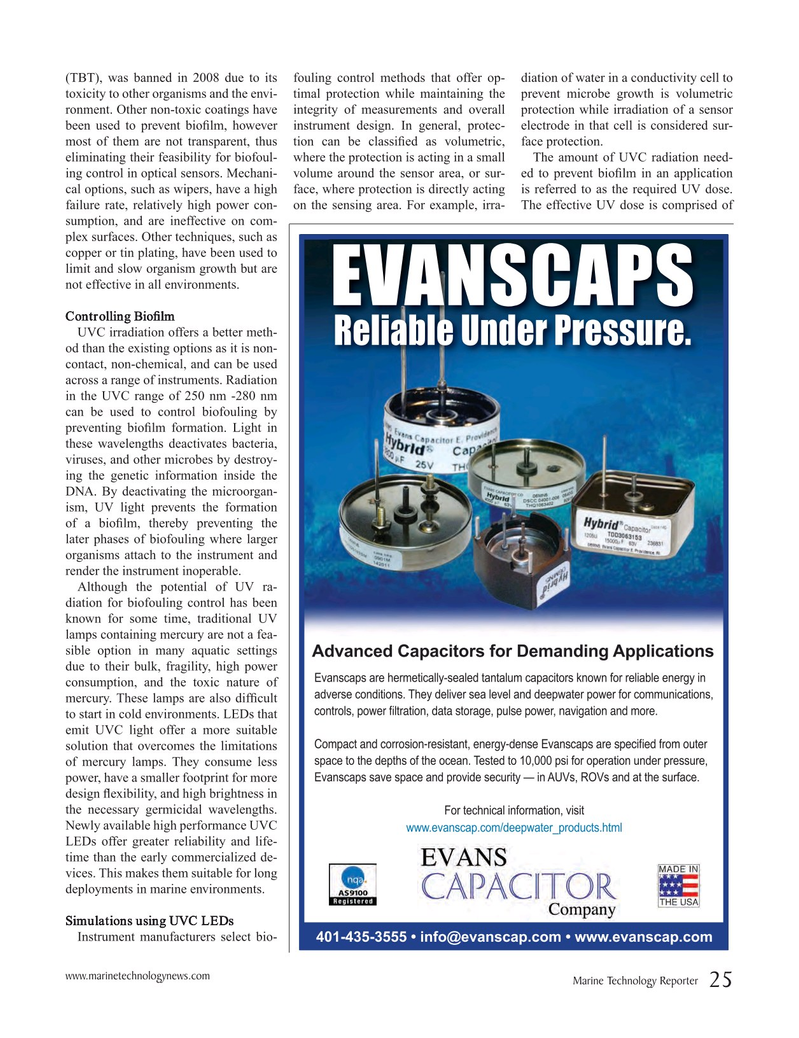
Page 25: of Marine Technology Magazine (March 2016)
Oceanographic Instrumentation: Measurement, Process & Analysis
Read this page in Pdf, Flash or Html5 edition of March 2016 Marine Technology Magazine
(TBT), was banned in 2008 due to its fouling control methods that offer op- diation of water in a conductivity cell to toxicity to other organisms and the envi- timal protection while maintaining the prevent microbe growth is volumetric ronment. Other non-toxic coatings have integrity of measurements and overall protection while irradiation of a sensor been used to prevent bio? lm, however instrument design. In general, protec- electrode in that cell is considered sur- most of them are not transparent, thus tion can be classi? ed as volumetric, face protection. eliminating their feasibility for biofoul- where the protection is acting in a small The amount of UVC radiation need- ing control in optical sensors. Mechani- volume around the sensor area, or sur- ed to prevent bio? lm in an application cal options, such as wipers, have a high face, where protection is directly acting is referred to as the required UV dose. failure rate, relatively high power con- on the sensing area. For example, irra- The effective UV dose is comprised of sumption, and are ineffective on com- plex surfaces. Other techniques, such as copper or tin plating, have been used to limit and slow organism growth but are not effective in all environments.
EVANSCAPS
Controlling Bio? lm
UVC irradiation offers a better meth-
Reliable Under Pressure.
od than the existing options as it is non- contact, non-chemical, and can be used across a range of instruments. Radiation in the UVC range of 250 nm -280 nm can be used to control biofouling by preventing bio? lm formation. Light in these wavelengths deactivates bacteria, viruses, and other microbes by destroy- ing the genetic information inside the
DNA. By deactivating the microorgan- ism, UV light prevents the formation of a bio? lm, thereby preventing the later phases of biofouling where larger organisms attach to the instrument and render the instrument inoperable.
Although the potential of UV ra- diation for biofouling control has been known for some time, traditional UV lamps containing mercury are not a fea- sible option in many aquatic settings $GYDQFHG&DSDFLWRUVIRU'HPDQGLQJ$SSOLFDWLRQV due to their bulk, fragility, high power
Evanscaps are hermetically-sealed tantalum capacitors known for reliable energy in consumption, and the toxic nature of adverse conditions. They deliver sea level and deepwater power for communications, mercury. These lamps are also dif? cult
FRQWUROVSRZHUÀOWUDWLRQGDWDVWRUDJHSXOVHSRZHUQDYLJDWLRQDQGPRUH to start in cold environments. LEDs that emit UVC light offer a more suitable &RPSDFWDQGFRUURVLRQUHVLVWDQWHQHUJ\GHQVH(YDQVFDSVDUHVSHFLÀHGIURPRXWHU solution that overcomes the limitations space to the depths of the ocean. Tested to 10,000 psi for operation under pressure, of mercury lamps. They consume less
Evanscaps save space and provide security — in AUVs, ROVs and at the surface. power, have a smaller footprint for more design ? exibility, and high brightness in the necessary germicidal wavelengths.
For technical information, visit
Newly available high performance UVC www.evanscap.com/deepwater_products.html
LEDs offer greater reliability and life- time than the early commercialized de- vices. This makes them suitable for long deployments in marine environments.
Simulations using UVC LEDs
Instrument manufacturers select bio- ?LQIR#HYDQVFDSFRP?ZZZHYDQVFDSFRP www.marinetechnologynews.com
Marine Technology Reporter 25
MTR #2 (18-33).indd 25 2/19/2016 11:13:06 AM

 24
24

 26
26
